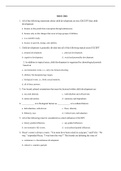Quick Quiz
1. All of the following statements about child development are true EXCEPT that child
development
a. focuses on the period from conception through adolescence.
b. focuses only on the changes that occur in large groups of children.
c. is a scientific study.
d. focuses on growth, change, and stability.
1. Child development is generally divided into all of the following topical areas EXCEPT
a. prenatal development. c. physical development.
b. cognitive development. d. social and personality development.
2. In addition to topical areas, child development is organized by chronological periods
based on
a. environmental events, i.e., entry into formal schooling.
b. arbitrary but designated age ranges.
c. biological events, i.e., birth, sexual maturity.
d. all of these answers.
3. Two broad cultural orientations that must be factored within child development are
a. race and ethnicity. c. individualism and collectivism.
b. nature and nurture. d. autonomy and dependence.
4. ___________ is to biological factors as ___________ is to cultural factors.
a. Individualism; collectivism c. Race; ethnicity
b. Ethnicity; race d. Collectivism; individualism
5. All of the following must be considered as cohort influences EXCEPT
a. history-graded influences. c. age-graded influences.
b. non-normative life events. d. sociocultural-graded influences.
6. Oscar’s room is always a mess. “You must have been raised in a pig pen,” said Felix. “No
way,” responded Oscar, “I was born this way!” The friends are debating the issue of
a. continuous vs. discontinuous development.
b. critical vs. sensitive periods.
, c. nature vs. nurture.
d. cultural vs. social development.
7. Sandy is pregnant and is concerned about the impact of illness during particular periods of
prenatal development. She consults her doctor as to the ___________ period during which
exposure to certain illnesses would result in irreversible consequences.
a. sensitive c. continuous
b. critical d. discontinuous
8. A child’s ability to think about objects symbolically represents a qualitative change in
cognitive development. The achievement of this step is an example of
a. continuous development. c. sensitive development.
b. discontinuous change. d. critical development.
1. “Every day I read another article with advice about raising my children. How can I know
what is true?” One piece of good advice for this new parent is
a. just do whatever your parents did. c. maintain a healthy dose of skepticism.
b. ask friends for advice. d. stop reading conflicting advice.
, Quick Quiz Answers
1. Chapter Section: An Orientation to Child Development
Answer: b Page(s): 4 Type: Factual Diff: Easy
Rationale: Child development involves the scientific study of the patterns of growth, change, and
stability that occur from conception through adolescence. While large groups of children may be
studied, they are not studied exclusively, nor are child development researchers concerned only with
changes.
2. Chapter Section: An Orientation to Child Development
Answer: a Page(s): 5 Type: Factual Diff: Easy
Rationale: The three major topics of child development are physical, cognitive, and social and
personality development. Prenatal development represents a time period that encompasses aspects of
the other three choices.
3. Chapter Section: An Orientation to Child Development
Answer: d Page(s): 5 Type: Factual Diff: Easy
Rationale: In addition to the topical divisions, the discipline is also focused on particular time periods
of development. These time periods (prenatal, infant and toddlerhood, early childhood, middle
childhood and adolescence) are determined by arbitrary, but agreed upon, designated age ranges,
biological events (i.e. sexual maturity) and environmental events (beginning of formal school).
4. Chapter Section: Developmental Diversity
Answer: c Page(s): 7 Type: Factual Diff: Medium
Rationale: There are both broad and finer sociocultural factors that child development specialists must
consider. An example from the textbook of two broad cultural orientations that influence development
is the individualistic and collectivist cultural orientation.
5. Chapter Section: Developmental Diversity
Answer: c Page(s): 7 Type: Factual Diff: Medium
Rationale: Race is a biological concept, referring to classifications based on physical and structural
characteristics of the species. Ethnicity, or ethnic group, is a broader category that refers to cultural
background, nationality, religion, and language.
6. Chapter Section: Developmental Diversity
Answer: b Page(s): 8 Type: Conceptual Diff: Difficult
Rationale: All of the answers represent influences that the developmental researcher must consider,
but non-normative life events are the ones that areis not cohort specific. Non-normative life events are
specific, atypical events that occur in a particular person’s life at a time when such events do not
happen to most people. The others represent influences that occur at a particular time in history
, (history-graded), or a particular chronological age (age-graded), or represent membership to a
particular subculture, ethnicity, or social class (socioculturally-graded). These three represent group
cohort influences.
7. Chapter Section: Children: Past, Present, and Future
Answer: c Page(s): 12 Type: Applied Diff: Difficult
Rationale: The debate between Oscar and Felix best represents the nature-versus-nurture debate.
Nature represents the belief that the cause is genetic or hormonal, while nurture represents
environment or experience. So, the friends’ debate becomes upbringing (nurture) or heredity (nature).
8. Chapter Section: Children: Past, Present, and Future
Answer: b Page(s): 10-11 Type: Applied Diff: Difficult
Rationale: Sandy is concerned about the critical period; a specific time when the illness would have its
greatest consequences. During this time, the concern is that there would be permanent, irreversible
harm done to the fetus. This is contrasted with the sensitive period, which is a specific time when an
organism is particularly susceptible to certain kinds of stimuli in the environment.




